Ecological Trap Effects in Migratory European Pied Flycatchers (Ficedula hypoleuca) Nesting in Pest Outbreak-Affected Forests
Simple Summary
Abstract
1. Introduction
2. Methods
2.1. Study Location and Experimental Setup
2.2. Food Resource Estimation
2.3. Tree Canopy Estimation
2.4. Data Analyses
2.5. Use of Artificial Intelligence
3. Results
3.1. Larval Biomass and Vegetation Parameters
3.2. Clutch Size
3.3. Fledglings
3.4. Fledgling Body Mass
3.5. Fledgling Tarsus Length
4. Discussion
Author Contributions
Funding
Institutional Review Board Statement
Data Availability Statement
Acknowledgments
Conflicts of Interest
References
- Schlaepfer, M.A.; Runge, M.C.; Sherman, P.W. Ecological and evolutionary traps. Trends Ecol. Evol. 2002, 17, 474–480. [Google Scholar] [CrossRef]
- Battin, J. When good animals love bad habitats: Ecological traps and the conservation of animal populations. Conserv. Biol. 2004, 18, 1482–1491. [Google Scholar] [CrossRef]
- Hildén, O. Habitat selection in birds: A review. In Annales Zoologici Fennici; Finnish Zoological and Botanical Publishing Board: Helsinki, Finland, 1965; Volume 2, pp. 53–75. [Google Scholar]
- Cody, M.L. (Ed.) Habitat Selection in Birds; Elsevier: Amsterdam, The Netherlands, 1987. [Google Scholar]
- Huhta, E.; Jokimäki, J.; Rahko, P. Breeding success of pied flycatchers in artificial forest edges: The effect of a suboptimally shaped foraging area. Auk 1999, 116, 528–535. [Google Scholar] [CrossRef]
- Sherley, R.B.; Ludynia, K.; Dyer, B.M.; Lamont, T.; Makhado, A.B.; Roux, J.P.; Scales, K.L.; Underhill, L.G.; Votier, S.C. Metapopulation tracking juvenile penguins reveals an ecosystem-wide ecological trap. Curr. Biol. 2017, 27, 563–568. [Google Scholar] [CrossRef] [PubMed]
- Sun, K.K.; Yu, W.S.; Jiang, J.J.; Richards, C.; Siemann, E.; Ma, J.; Li, B.; Ju, R.T. Mismatches between the resources for adult herbivores and their offspring suggest invasive Spartina alterniflora is an ecological trap. J. Ecol. 2020, 108, 719–732. [Google Scholar] [CrossRef]
- Hale, R.; Treml, E.A.; Swearer, S.E. Evaluating the metapopulation consequences of ecological traps. Proc. R. Soc. B Biol. Sci. 2015, 282, 20142930. [Google Scholar] [CrossRef]
- Robertson, B.A.; Hutto, R.L. A framework for understanding ecological traps and an evaluation of existing evidence. Ecology 2006, 87, 1075–1085. [Google Scholar] [CrossRef]
- Hale, R.; Swearer, S.E. Ecological traps: Current evidence and future directions. Proc. R. Soc. B Biol. Sci. 2016, 283, 20152647. [Google Scholar] [CrossRef]
- Hale, R.; Swearer, S.E. When good animals love bad restored habitats: How maladaptive habitat selection can constrain restoration. J. Appl. Ecol. 2017, 54, 1478–1486. [Google Scholar] [CrossRef]
- Richards, D.R.; Belcher, R.N.; Carrasco, L.R.; Edwards, P.J.; Fatichi, S.; Hamel, P.; Masoudi, M.; McDonnell, M.J.; Peleg, N.; Stanley, M.C. Global variation in contributions to human well-being from urban vegetation ecosystem services. One Earth 2022, 5, 522–533. [Google Scholar] [CrossRef]
- Barbosa, P.; Letourneau, D.K.; Agrawal, A.A. (Eds.) Insect Outbreaks Revisited; John Wiley & Sons: Hoboken, NJ, USA, 2012. [Google Scholar]
- Moulinier, J.; Lorenzetti, F.; Bergeron, Y. Effects of a forest tent caterpillar outbreak on the dynamics of mixedwood boreal forests of eastern Canada. Ecoscience 2013, 20, 182–193. [Google Scholar] [CrossRef]
- Vindstad, O.P.L.; Jepsen, J.U.; Ims, R.A. Resistance of a sub-arctic bird community to severe forest damage caused by geometrid moth outbreaks. Eur. J. For. Res. 2015, 134, 725–736. [Google Scholar] [CrossRef][Green Version]
- Daily, G.C.; Matson, P.A. Ecosystem services: From theory to implementation. Proc. Natl. Acad. Sci. USA 2008, 105, 9455–9456. [Google Scholar] [CrossRef] [PubMed]
- Swinton, S.M.; Lupi, F.; Robertson, G.P.; Hamilton, S.K. Ecosystem services and agriculture: Cultivating agricultural ecosystems for diverse benefits. Ecol. Econ. 2007, 64, 245–252. [Google Scholar] [CrossRef]
- Tscharntke, T.; Clough, Y.; Wanger, T.C.; Jackson, L.; Motzke, I.; Perfecto, I.; Vandermeer, J.; Whitbread, A. Global food security, biodiversity conservation and the future of agricultural intensification. Biol. Conserv. 2012, 151, 53–59. [Google Scholar] [CrossRef]
- Langelier, L.A.; Garton, E.O. Management Guidelines for Increasing Populations of Birds That Feed on Western Spruce Budworm (No. 653); US Department of Agriculture, Forest Service, Cooperative State Research Service: Washington, DC, USA, 1986. [Google Scholar]
- Duan, J.J.; Bauer, L.S.; Abell, K.J.; Ulyshen, M.D.; Van Driesche, R.G. Population dynamics of an invasive forest insect and associated natural enemies in the aftermath of invasion: Implications for biological control. J. Appl. Ecol. 2015, 52, 1246–1254. [Google Scholar] [CrossRef]
- Mols, C.M.; Visser, M.E. Great tits can reduce caterpillar damage in apple orchards. J. Appl. Ecol. 2002, 39, 888–899. [Google Scholar] [CrossRef]
- Mols, C.M.; Visser, M.E. Great tits (Parus major) reduce caterpillar damage in commercial apple orchards. PLoS ONE 2007, 2, e202. [Google Scholar] [CrossRef]
- Mols, C.M.; Van Noordwijk, A.J.; Visser, M.E. Assessing the reduction of caterpillar numbers by Great Tits Parus major breeding in apple orchards. Ardea 2005, 93, 259. [Google Scholar]
- Wesoowski, T. Reports from nestbox studies: A review of inadequacies. Acta Ornithol. 2011, 46, 13–17. [Google Scholar] [CrossRef]
- Maziarz, M.; Wesołowski, T.; Hebda, G.; Cholewa, M.; Broughton, R.K. Breeding success of the Great Tit Parus major in relation to attributes of natural nest cavities in a primeval forest. J. Ornithol. 2016, 157, 343–354. [Google Scholar] [CrossRef]
- Mänd, R.; Tilgar, V.; Lõhmus, A.; Leivits, A. Providing nest boxes for hole-nesting birds–Does habitat matter? Biodivers. Conserv. 2005, 14, 1823–1840. [Google Scholar] [CrossRef]
- Kilgas, P.; Tilgar, V.; Mägi, M.; Mänd, R. Physiological condition of incubating and brood rearing female Great Tits Parus major in two contrasting habitats. Acta Ornithol. 2007, 42, 129–136. [Google Scholar] [CrossRef]
- Krams, R.; Krama, T.; Brūmelis, G.; Elferts, D.; Strode, L.; Dauškane, I.; Luoto, S.; Šmits, A.; Krams, I.A. Ecological traps: Evidence of a fitness cost in a cavity-nesting bird. Oecologia 2021, 196, 735–745. [Google Scholar] [CrossRef]
- Lundberg, A.; Alatalo, R.V. The Pied Flycatcher; T. & A. D. Poyser: London, UK, 1992. [Google Scholar]
- Merino, S.; Potti, J. Pied flycatchers prefer to nest in clean nest boxes in an area with detrimental nest ectoparasites. Condor 1995, 97, 828–831. [Google Scholar] [CrossRef]
- Atlegrim, O.; Sjöberg, K. Effects of clear-cutting and selective felling in Swedish boreal coniferous forest: Response of invertebrate taxa eaten by birds. Entomol. Fenn. 1995, 6, 79–90. [Google Scholar] [CrossRef]
- Voolma, K.; Hiiesaar, K.; Williams, I.H.; Ploomi, A.; Jõgar, K. Cold hardiness in the pre-imaginal stages of the great web-spinning pine-sawfly A cantholyda posticalis. Agric. For. Entomol. 2016, 18, 432–436. [Google Scholar] [CrossRef]
- Brichta, J.; Vacek, S.; Vacek, Z.; Cukor, J.; Mikeska, M.; Bílek, L.; Šimůnek, V.; Gallo, J.; Brabec, P.; Štefančík, I. Importance and potential of Scots pine (Pinus sylvestris L.) in 21st century. Cent. Eur. For. J. 2023, 69, 3–20. [Google Scholar] [CrossRef]
- Brūmelis, G.; Dauškane, I.; Elferts, D.; Strode, L.; Krama, T.; Krams, I. Estimates of tree canopy closure and basal area as proxies for tree crown volume at a stand scale. Forests 2020, 11, 1180. [Google Scholar] [CrossRef]
- Yazdanian, M.; Kankaanpää, T.; Merckx, T.; Huikkonen, I.M.; Itämies, J.; Jokimäki, J.; Lehikoinen, A.; Leinonen, R.; Pöyry, J.; Sihvonen, P.; et al. Evidence for bottom-up effects of moth abundance on forest birds in the north-boreal zone alone. Ecol. Lett. 2024, 27, e14467. [Google Scholar] [CrossRef]
- Schebeck, M.; Lehmann, P.; Laparie, M.; Bentz, B.J.; Ragland, G.J.; Battisti, A.; Hahn, D.A. Seasonality of forest insects: Why diapause matters. Trends Ecol. Evol. 2024, 39, 757–770. [Google Scholar] [CrossRef] [PubMed]
- Krama, T.; Vrublevska, J.; Freeberg, T.M.; Kullberg, C.; Rantala, M.J.; Krams, I. You mob my owl, I’ll mob yours: Birds play tit-for-tat game. Sci. Rep. 2012, 2, 800. [Google Scholar] [CrossRef]
- Loukola, O.J.; Seppänen, J.T.; Krams, I.; Torvinen, S.S.; Forsman, J.T. Observed fitness may affect niche overlap in competing species via selective social information use. Am. Nat. 2013, 182, 474–483. [Google Scholar] [CrossRef]
- Dhondt, A.A. Interspecific Competition in Birds; Oxford University Press: Oxford, UK, 2012; Volume 2. [Google Scholar]
- Kilgas, P.; Tilgar, V.; Mänd, R. Hematological health state indices predict local survival in a small passerine bird, the great tit (Parus major). Physiol. Biochem. Zool. 2006, 79, 565–572. [Google Scholar] [CrossRef] [PubMed]
- Rytkönen, S.; Krams, I. Does foraging behaviour explain the poor breeding success of great tits Parus major in northern Europe? J. Avian Biol. 2003, 34, 288–297. [Google Scholar] [CrossRef]
- Rytkönen, S.; Orell, M. Great tits, Parus major, lay too many eggs: Experimental evidence in mid-boreal habitats. Oikos 2001, 93, 439–450. [Google Scholar] [CrossRef]
- Tinbergen, J.M.; Dietz, M.W. Parental energy expenditure during brood rearing in the great tit (Parus major) in relation to body mass, temperature, food availability and clutch size. Funct. Ecol. 1994, 8, 563–572. [Google Scholar] [CrossRef]
- Zandt, H.S. A comparison of three sampling techniques to estimate the population size of caterpillars in trees. Oecologia 1994, 97, 399–406. [Google Scholar] [CrossRef]
- Rautiainen, M.; Mõttus, M.; Stenberg, P.; Ervasti, S. Crown envelope shape measurements and models. Silva Fenn. 2008, 42, 19. [Google Scholar] [CrossRef]
- R Core Team. R: A Language and Environment for Statistical Computing; R Foundation for Statistical Computing: Vienna, Austria, 2024. [Google Scholar]
- Bürkner, P.C. brms: An R package for Bayesian multilevel models using Stan. J. Stat. Softw. 2017, 80, 1–28. [Google Scholar] [CrossRef]
- Makowski, D.; Ben-Shachar, M.S.; Lüdecke, D. bayestestR: Describing effects and their uncertainty, existence and significance within the Bayesian framework. J. Open Source Softw. 2019, 4, 1541. [Google Scholar] [CrossRef]
- Enemar, A.; Sjöstrand, B.; Andersson, G.; Von Proschwitz, T. The 37-year dynamics of a subalpine passerine bird community, with special emphasis on the influence of environmental temperature and Epirrita autumnata cycles. Ornis Svec. 2004, 14, 63–106. [Google Scholar] [CrossRef]
- Lindström, Å. Breeding nomadism and site tenacity in the brambling Fringilla montifringilla. Ornis Fenn. 1987, 64, 50–56. [Google Scholar]
- Enemar, A.; Nyström, B. Population fluctuations, food and breeding of the Redpoll Carduelis flammea in a mountain birch forest, Swedish Lapland. Vår Fågelvärld 1981, 40, 409–426. [Google Scholar]
- Lamb, C.T.; Mowat, G.; McLellan, B.N.; Nielsen, S.E.; Boutin, S. Forbidden fruit: Human settlement and abundant fruit create an ecological trap for an apex omnivore. J. Anim. Ecol. 2017, 86, 55–65. [Google Scholar] [CrossRef] [PubMed]
- Misenhelter, M.D.; Rotenberry, J.T. Choices and consequences of habitat occupancy and nest site selection in Sage Sparrows. Ecology 2000, 81, 2892–2901. [Google Scholar] [CrossRef]
- Weldon, A.J.; Haddad, N.M. The effects of patch shape on Indigo Buntings: Evidence for an ecological trap. Ecology 2005, 86, 1422–1431. [Google Scholar] [CrossRef]
- Robinson, S.K.; Holmes, R.T. Foraging behavior of forest birds: The relationships among search tactics, diet, and habitat structure. Ecology 1982, 63, 1918–1931. [Google Scholar] [CrossRef]
- Ghimire, R.P.; Markkanen, J.M.; Kivimaenpaa, M.; Lyytikainen-Saarenmaa, P.; Holopainen, J.K. Needle removal by pine sawfly larvae increases branch-level VOC emissions and reduces below-ground emissions of Scots pine. Environ. Sci. Technol. 2013, 47, 4325–4332. [Google Scholar] [CrossRef]
- Mopper, S.; Whitham, T.G.; Price, P.W. Plant phenotype and interspecific competition between insects determine sawfly performance and density. Ecology 1990, 71, 2135–2144. [Google Scholar] [CrossRef]
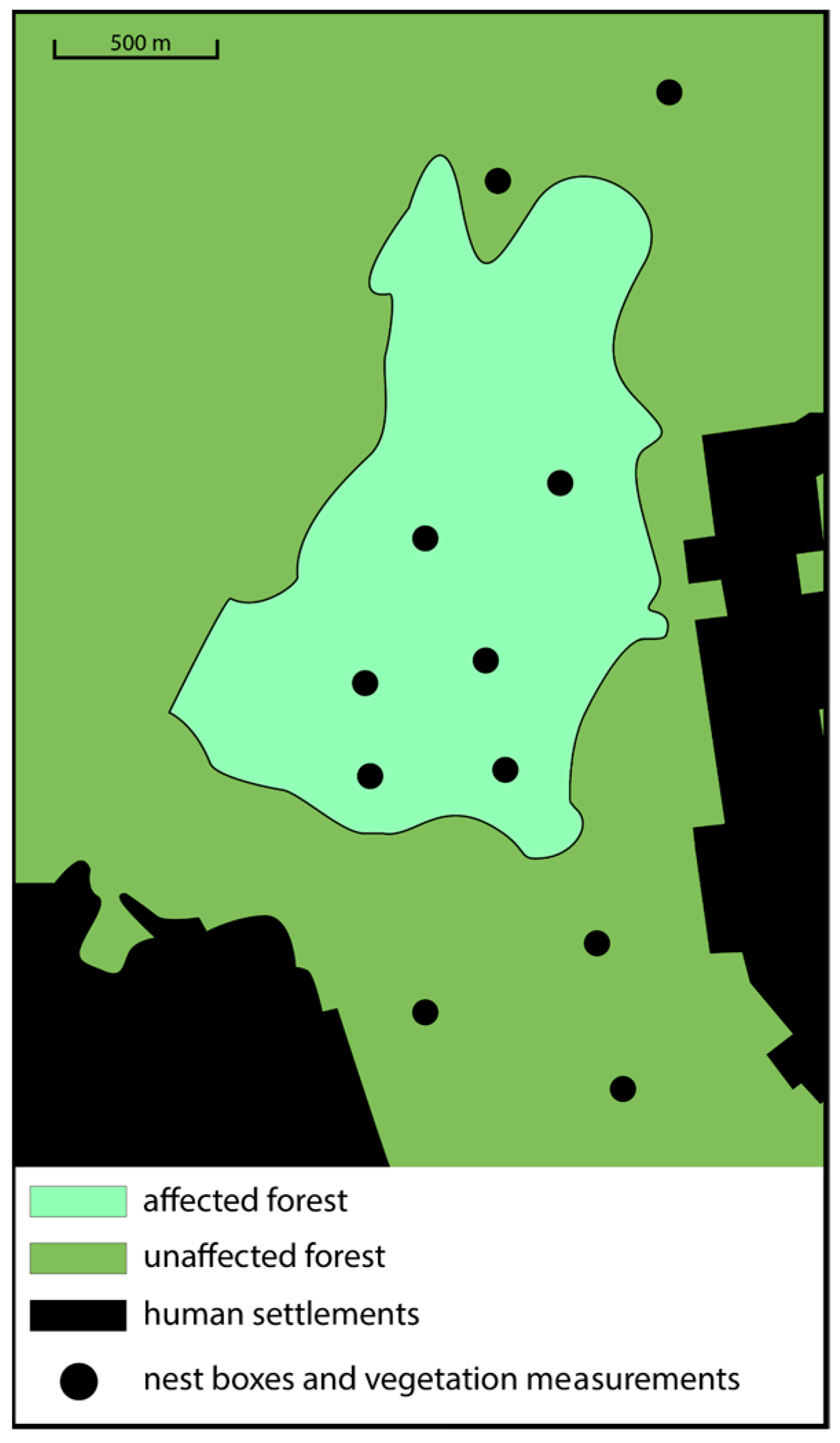

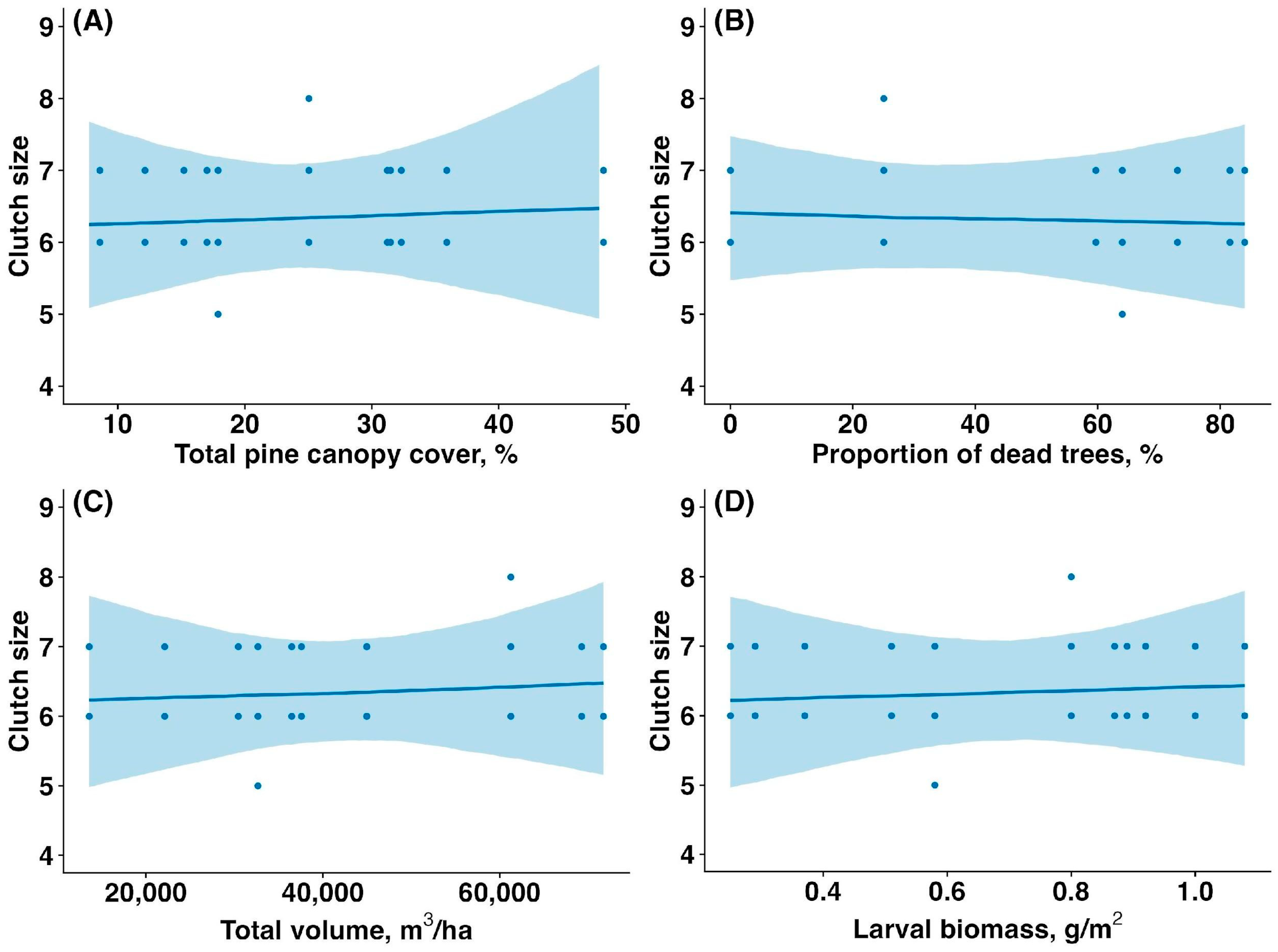
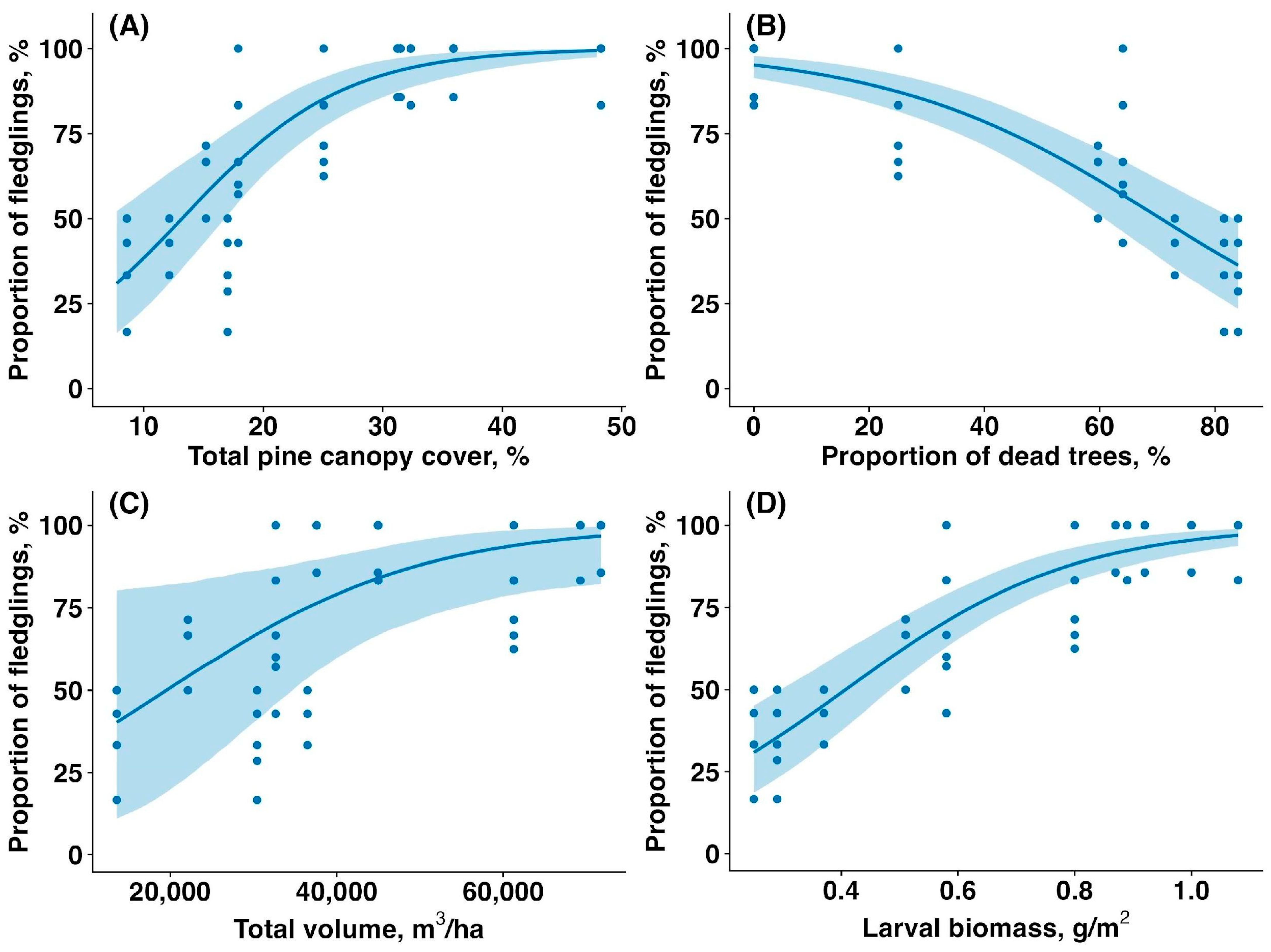
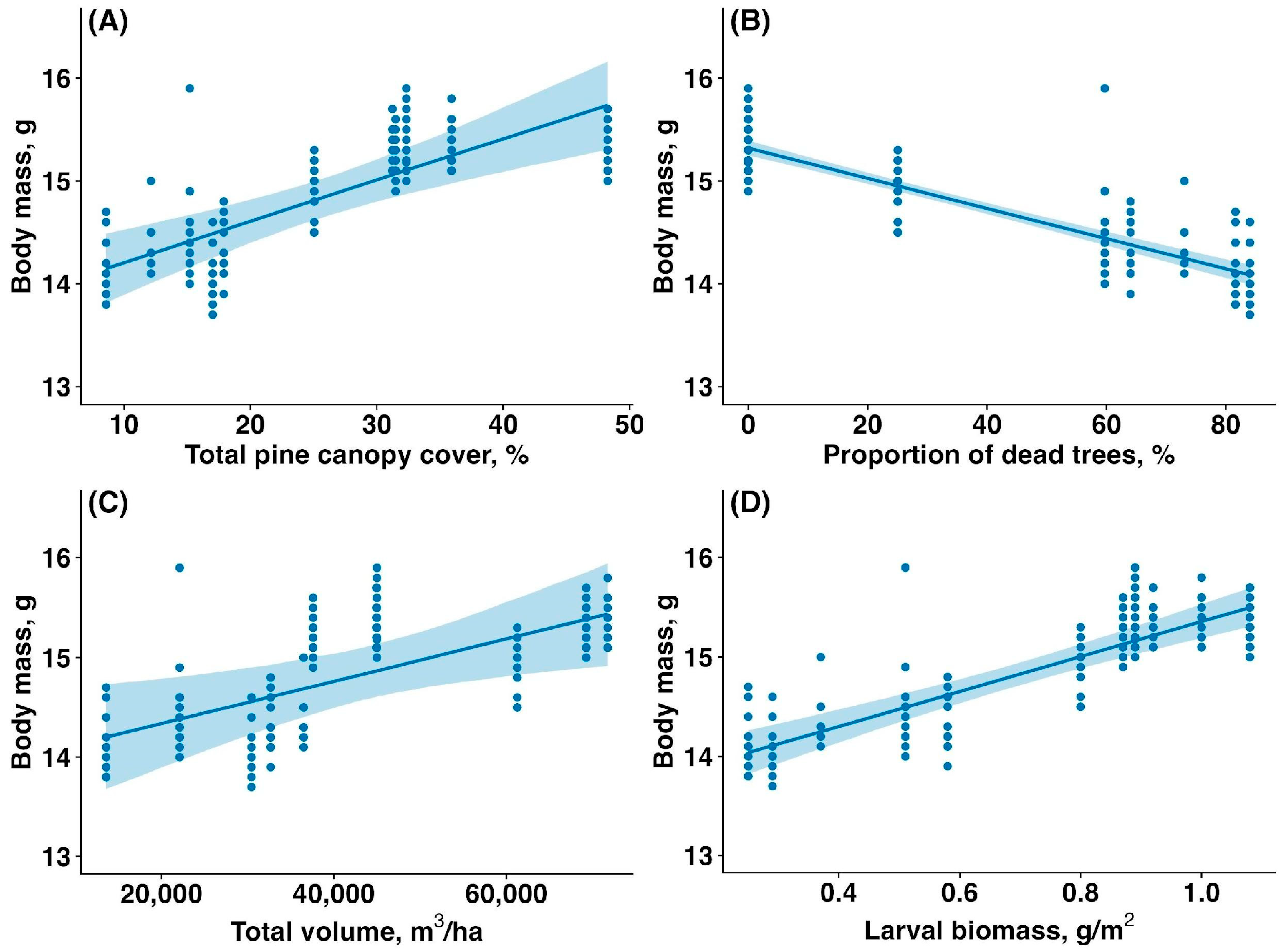
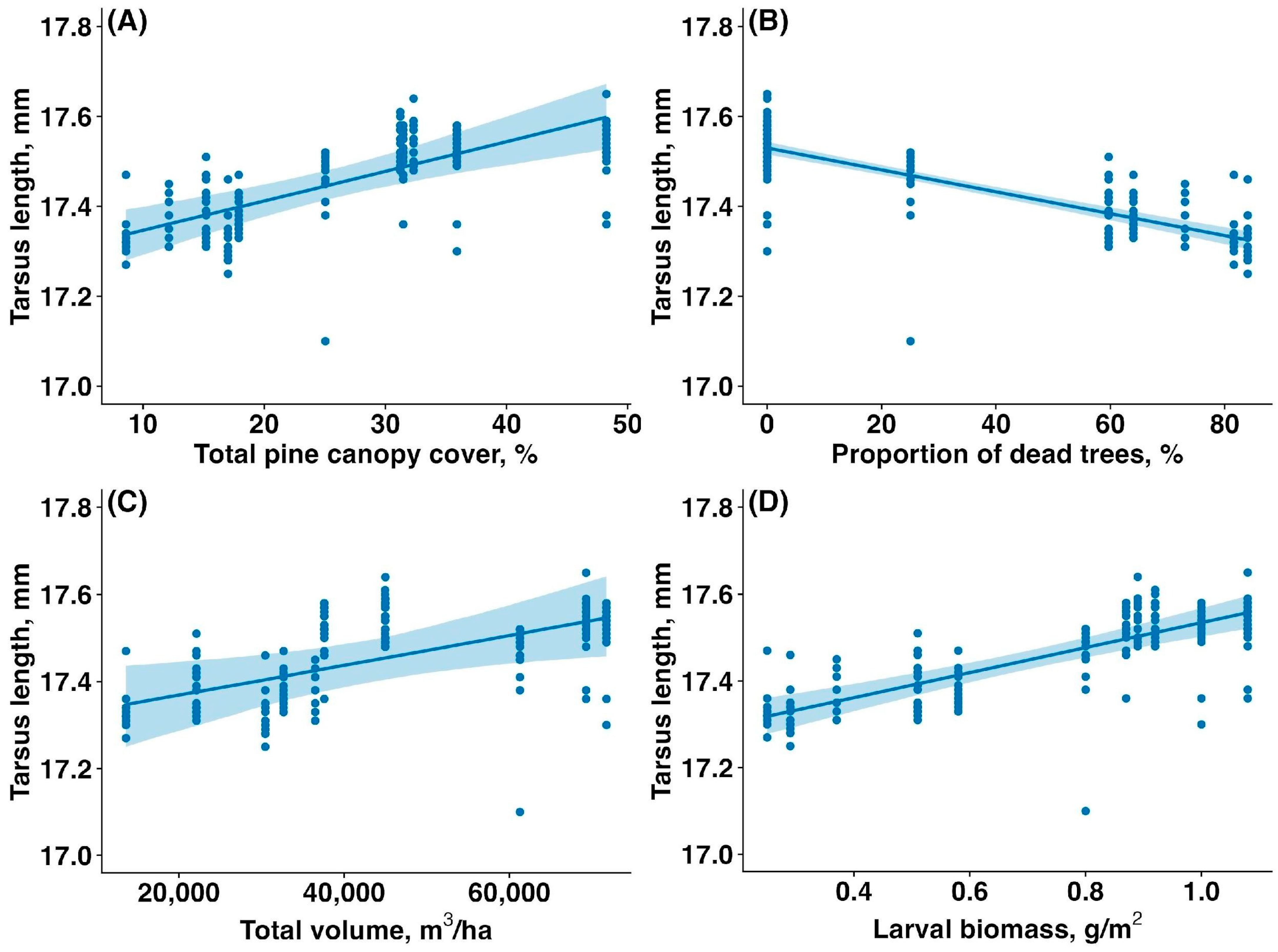
Disclaimer/Publisher’s Note: The statements, opinions and data contained in all publications are solely those of the individual author(s) and contributor(s) and not of MDPI and/or the editor(s). MDPI and/or the editor(s) disclaim responsibility for any injury to people or property resulting from any ideas, methods, instructions or products referred to in the content. |
© 2025 by the authors. Licensee MDPI, Basel, Switzerland. This article is an open access article distributed under the terms and conditions of the Creative Commons Attribution (CC BY) license (https://creativecommons.org/licenses/by/4.0/).
Share and Cite
Adams, C.B.; Krams, R.; Elferts, D.; Brūmelis, G.; Dauškane, I.; Strode, L.; Šmits, A.; Trakimas, G.; Krams, I.A.; Krama, T. Ecological Trap Effects in Migratory European Pied Flycatchers (Ficedula hypoleuca) Nesting in Pest Outbreak-Affected Forests. Birds 2025, 6, 27. https://doi.org/10.3390/birds6020027
Adams CB, Krams R, Elferts D, Brūmelis G, Dauškane I, Strode L, Šmits A, Trakimas G, Krams IA, Krama T. Ecological Trap Effects in Migratory European Pied Flycatchers (Ficedula hypoleuca) Nesting in Pest Outbreak-Affected Forests. Birds. 2025; 6(2):27. https://doi.org/10.3390/birds6020027
Chicago/Turabian StyleAdams, Colton B., Ronalds Krams, Didzis Elferts, Guntis Brūmelis, Iluta Dauškane, Linda Strode, Agnis Šmits, Giedrius Trakimas, Indrikis A. Krams, and Tatjana Krama. 2025. "Ecological Trap Effects in Migratory European Pied Flycatchers (Ficedula hypoleuca) Nesting in Pest Outbreak-Affected Forests" Birds 6, no. 2: 27. https://doi.org/10.3390/birds6020027
APA StyleAdams, C. B., Krams, R., Elferts, D., Brūmelis, G., Dauškane, I., Strode, L., Šmits, A., Trakimas, G., Krams, I. A., & Krama, T. (2025). Ecological Trap Effects in Migratory European Pied Flycatchers (Ficedula hypoleuca) Nesting in Pest Outbreak-Affected Forests. Birds, 6(2), 27. https://doi.org/10.3390/birds6020027







